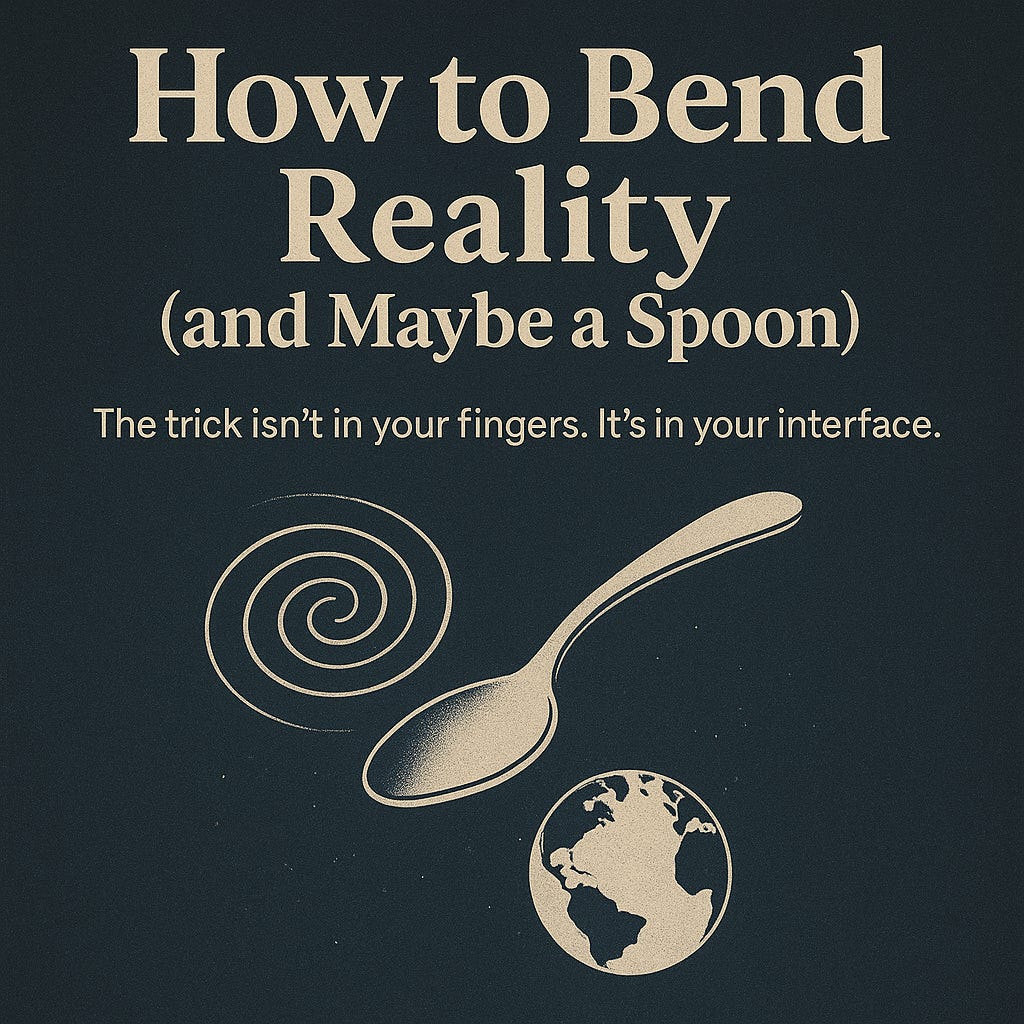How to Bend Reality (and Maybe a Spoon)
The trick isn’t in your fingers. It’s in your interface.
There’s a trick to bending spoons, but it’s not in the wrist or the metal. It emerges somewhere quieter, in that liminal hush between certainty and doubt, where the edges of what’s possible begin to shimmer, distort, and blur. Most people hesitate at that threshold. Some back away entirely when reality softens and structure feels negotiable—when solidity starts to feel like an old agreement that could, in a moment, be undone.
I know how that sounds. I used to dismiss mind-over-matter as wishful thinking dressed in stage lighting until one of the most rational men ever to walk the Moon invited me to un-think.
The Astronaut and the Glitch
In 1971, Edgar Mitchell walked on the Moon. A systems engineer, Navy captain, and MIT-trained physicist, Mitchell embodied the pinnacle of reason. But on the way home, staring out at the infinite, he felt himself dissolve into it. What followed was what he called a samadhi experience—a complete immersion in the cosmos, not as a feeling or belief, but as an encounter that imprinted itself so deeply he never really came back the same.
That single moment ended the career NASA had prepared him for and launched something stranger. Mitchell didn’t abandon reason; he simply followed it to its edge, and then past it. Where logic ended, the Glitch began.
The Spoon-Bender
One year later, Mitchell coordinated confidential experiments at Stanford Research Institute. The subject was Uri Geller, the Israeli performer famous for claiming he could bend spoons with his mind. To most scientists, it was theater. To Mitchell, it was a test worth running.
The results—images drawn from sealed envelopes, disruptions to magnetometers in shielded labs, metal bending without apparent contact—remain controversial. Skeptics muttered “coincidence” and “sleight of hand.” But Mitchell wasn’t looking for a stage show, or even proof. He was listening for a signal, something faint and real, woven so subtly into the fabric of reality that most people miss it entirely.
This wasn’t about magic. It wasn’t mystical. It was a loosening at the border between thought and thing, a phenomenon that arrived not through will, but through field. Something you feel before you understand.
The Physics of the Impossible
Skeptics will list the usual: coincidence, confirmation bias, and fraud. Maybe. But they still can’t quite explain why human intention modulates random number generators. Or why groups meditating together produce measurable effects in electromagnetic fields. Or why, across cultures, people in altered states report time slowing, objects shifting, and reality behaving less like a machine and more like a song.
These effects don’t arrive by force. They arise through coherence—through a kind of resonance deeper than belief. The question isn’t just whether consciousness witnesses reality. It’s whether consciousness interfaces with it subtly, structurally, like a tuning fork pressed against the scaffolding of reality.
Try It
Tonight, when the world is still and the air feels thin, find a spoon. Not a trick spoon, just one you’re willing to sacrifice. Sit alone. Let your breath slow. Let the rhythm of your pulse expand into the quiet. And then—don’t try to bend it. Don’t force anything. Just hold it lightly, as if it’s already bending.
Picture the metal softening in your hand, not under pressure but perception. Let it feel absurd. That’s how you know the boundaries are beginning to flex. Say it like it’s already true: “It’s already happening.”
If nothing happens, that’s fine. If something does, if the room shifts, or the spoon feels strange in your fingers, you’ll likely tell yourself it was nothing. And that’s fine too. But you’ll know something listened.
You’ve Already Done Stranger Things
A thought spikes your blood pressure.
A memory prickles your skin.
An emotion rewires time.
Love rearranges chemistry.
Loss remaps space.
You’re not waiting to believe in something strange. You already are something strange.
So maybe the question isn’t whether you can bend a spoon. Maybe the question is: Who taught you you couldn’t?
The Real Trick
The spoon isn’t the point. It never was. It’s a decoy—something to hold while you examine the deeper structure. Because what bends, when you reach into that stillness, isn’t just the metal. It’s your expectation. And once that flexes, reality starts making room.
These phenomena don’t arrive when you’re convinced. They arrive when you’re clear. No resistance. No effort. Just… signal.
Call it entrainment. Call it alignment. Call it a handshake through the veil. But whatever it is, it knows when you’re bluffing. And it prefers sincerity over strategy. It shows up when you stop needing to be right.
Final Transmission
If you find yourself, late at night, holding a spoon that seems to shift at the edge of your attention, you’ll likely explain it away. A trick of the hand. A play of the light. A coincidence. That’s fine.
Because the spoon was never the test.
You were.
And if mind and matter are even slightly entangled, if the boundary between them can flex, even a little, then maybe we’ve been measuring reality with the wrong instruments all along.
Maybe the spoon was never metal.
Just metaphor.
“The universe is not simply an array of physical phenomena following physical laws, but includes consciousness as a fundamental part of its nature.”
— Edgar Mitchell





